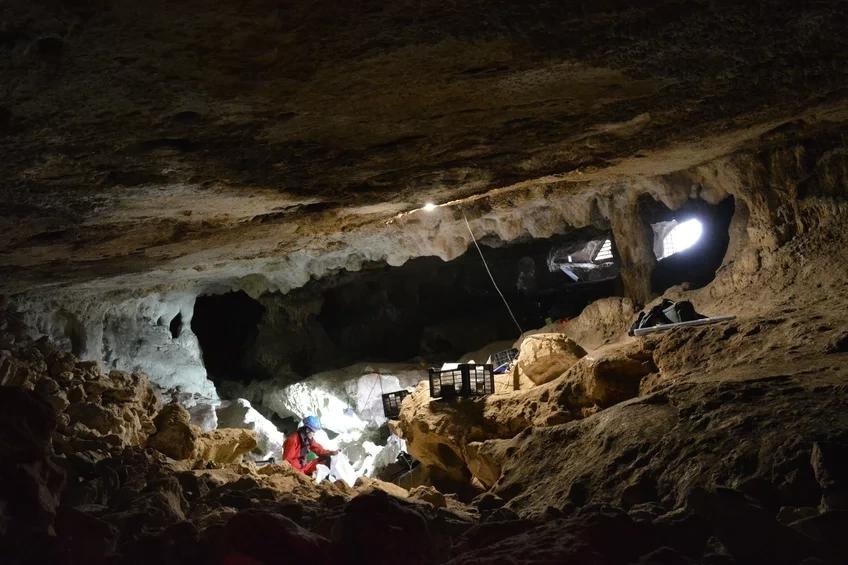Reviewed by Danielle Ellis, B.Sc.Mar 2 2023
Recent research discloses genomic data from a 23,000-year-old individual who inhabited what was most likely Europe’s warmest location during the last Ice Age. The oldest human genome retrieved from the southern tip of Spain provides a significant puzzle piece to Europe's genetic history.
 Overview of Cueva de Malalmuerzo. Image Credit: © Pedro Cantalejo
Overview of Cueva de Malalmuerzo. Image Credit: © Pedro Cantalejo
An international research team examined ancient human DNA from archaeological sites in Andalucía, Spain’s southernmost region. The study reports on the oldest genome discovered to date from Cueva del Malalmuerzo in southern Spain and the 7,000 to 5,000-year-old genomes of early farmers discovered at other well-known sites, such as Cueva de Ardales.
The Iberian Peninsula is pivotal in reconstructing human population history. As a geographical cul-de-sac in southwest Europe, it was regarded a refuge during the last Ice Age due to its extreme temperature fluctuations.
On the other hand, it could have been one of the starting points for Europe’s recolonization following the glacial maximum. Indeed, earlier studies on the genomic profiles of 13,000 to 8,000-year-old hunter-gatherers from the Iberian Peninsula presented proof for the survival and continuation of a much older Palaeolithic lineage that has been modified and is no longer detectable in other parts of Europe.
After an organism dies, its DNA is only protected for a limited time and under ideal environmental conditions. Researchers face a significant challenge in extracting DNA from ancient remains found in hot and dry climates.
Climate conditions in Andalucía, in the south of modern-day Spain, are similar to those in North Africa; however, DNA from 14,000-year-old human individuals retrieved from a cave site in Morocco has been successfully recovered.
The new study closes important temporal and spatial gaps. Researchers can now investigate the southern Iberian Peninsula's role as a refuge for Ice Age populations and prospective population contacts across the Strait of Gibraltar during the last Ice Age when sea levels were much lower than they are today.
In the right place at the right time
People from central and southern Europe who resided before the Last Glacial Maximum (24,000 to 18,000 years ago) have different genetic ancestors than those who recolonized Europe afterward. However, given the lack of genomic data from crucial time periods, the situation in Western Europe has been unclear until now.
The 23,000-year-old individual from Cueva del Malalmuerzo near Granada eventually adds data from a time when huge ice sheets covered large parts of Europe. The study presents a straightforward genetic link between a 35,000-year-old individual from Belgium and Malalmuerzo’s new genome.
Thanks to the high quality of our data we were able to detect traces of one of the first genetic lineages that settled Eurasia 45,000 years ago. Importantly, we found similarities with a 35,000-year-old individual from Belgium whose ancestry we can now trace further to the 23,000-year-old individual from southern Iberia.”
Vanessa Villalba-Mouco, Study First Author, Max Planck Institute for Evolutionary Anthropology
Individuals from Cueva del Malalmuerzo have ties not only to earlier periods of settlement but also to hunter-gatherers from southern and western Europe who survived long after the last Ice Age. It also affirms the Iberian Peninsula’s importance as a safe haven for human populations during the last Ice Age. Once the ice sheets retreated, humans relocated northwards and eastwards.
With Malalmuerzo, we managed to find the right place and the right time period to trace a Palaeolithic human group back to one of the proposed Ice Age refugia. It is remarkable to find such a long-lasting genetic legacy on the Iberian Peninsula, especially since this pre-Ice Age ancestry had long since disappeared in other parts of Europe.”
Wolfgang Haak, Study Senior Author, Max Planck Institute for Evolutionary Anthropology
More puzzle pieces of human history
Despite only 13 km across the Mediterranean Sea and archaeological parallels, the authors found no genetic link between the southern Iberian Peninsula and North Africa.
In Malalmuerzo, we found no evidence of a genetic contribution from North African lineages, and conversely, there is no evidence of a genetic contribution from southern Spain in the genomes of the 14,000-year-old individuals from the Taforalt cave in Morocco. Why the Strait of Gibraltar was a barrier at the end of the last Ice Age is still one of the unresolved questions of archaeological research in the western Mediterranean region."
Gerd-Christian Weniger, University of Cologne
The research also includes several younger Neolithic people from the time when the first farmers reached Europe from the Near East. People from Andalucía have the characteristic genetic ancestry of Anatolian Neolithic groups, indicating that these early farmers spread over large geographic distances.
“Neolithic people from southern Iberia, however, show a higher proportion of hunter-gatherer lineages. Hence, interaction between the last hunters and the first farmers may have been much closer than in other regions,” states co-author Jose Ramos-Muñoz from Universidad de Cádiz.
The Iberian Peninsula’s unique role during the Ice Age has reverberated for thousands of years.
Vanessa Villalba-Mouco concludes, “Surprisingly, the genetic heritage of Paleolithic hunter-gatherers is still detectable in early farmers from southern Iberia, indicating local admixture between two population groups with very different lifestyles.”
Source:
Journal reference:
Villalba-Mouco, V., et al. (2023) A 23,000-year-old southern Iberian individual links human groups that lived in Western Europe before and after the Last Glacial Maximum. Nature Ecology & Evolution. doi.org/10.1038/s41559-023-01987-0.